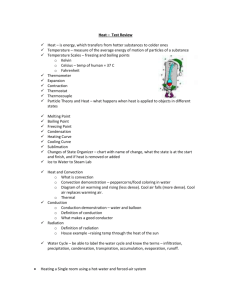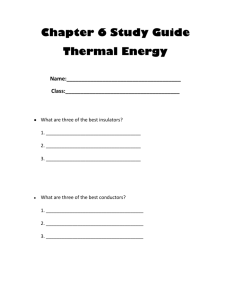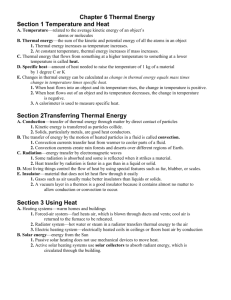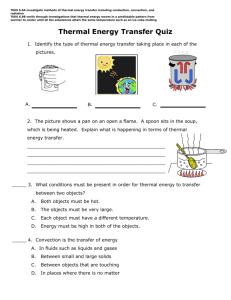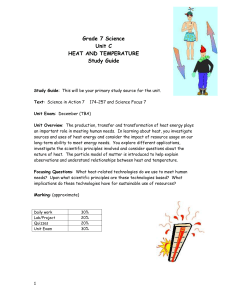Energy 1
advertisement
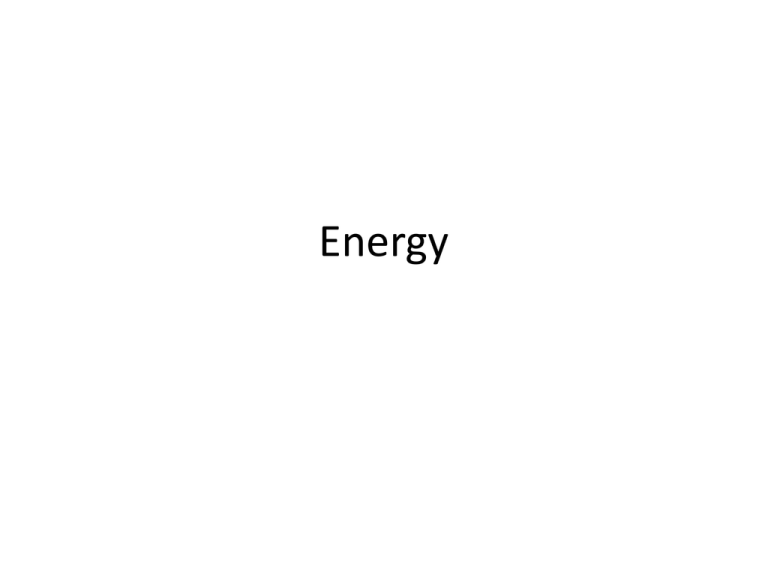
Energy Temperature • Temperature is related to the average kinetic energy of an object’s atoms or molecules. Thermal energy • Thermal energy is the sum of the kinetic and potential energy of all the atoms in an object. • Thermal Energy increases as the temperature increases. • At constant temperature, thermal increases if mass increases. Heat • Thermal energy that flows from something at a higher temprature to something at a lower temperature is called heat. • When you hold ice, how does your hands feel. Does the ice remain frozen or does it melt? Specific Heat • The specific heat is the amount of heat needed to raise the temperature of 1 kg of a material by 1 degree Celsius or Kelvin. Thermal Energy Change • Changes in thermal energy can be calculated as change in thermal energy equals mass times change in temperature times specific heat. Positive Change • When heat flows into an object and its temperature rises, the change in temperature is positive. Negative • When heat flows out of an object and its temperature decreases, the change in temperature is negative. Question • How do temperature and heat differ? Answer • Heat is thermal energy that flows from something warmer to something colder while temperature is related to kinetic energy of atoms in a substance. Calorimeter • A calorimeter is used to measure specific heat. Conduction • Conduction is the transfer of thermal energy through matter by direct contact of particles. Conduction • In conduction, the kinetic energy is transferred as particles collide. • Solids, particularly metals, are good conductors. Convection • The transfer of energy by the motion of heated particles in a fluid is called convection. Convection currents • Convection currents transfer heat from warmer to cooler parts of a fluid. • Convection currents create rain forests and deserts over different regions (parts) of Earth. Radiation • Radiation is energy transfer by electromagnetic waves. Radiation • Some radiation is absorbed and some is reflected when it strikes a material. • Heat transfer by radiation is faster in a gas than in a liquid or solid. Flow of Heat • Most living things control the flow of heat by using special features such as fur, blubber, or scales. Insulator • Insulators are materials that do not let heat flow through them easily. Insulators • Gases such as air usually make better insulators than liquids or solids. • A vacuum layer in a thermos is a good insulator because it contains almost no matter to allow conduction or convection to occur. Question • What state of matter makes it a good conductor? Heat insulator? Answer • Solids generally conduct heat better than liquids or gases. Gases usually make better insulators than liquids or solids. Heating Systems • Heating Systems warm homes and buildings. • What type of heating system do you have? Forced-Air System • Forced-Air Systems are systems in which the fuel heats the air, which is blown through ducts and vents. Cool air is returned to the furnace to be heated. Radiator System • A radiator system is a system in which hot water or steam in a radiator transfers thermal energy to the air. Electric Heating System • Electric Heating System is a system that has electrically heated coils in ceilings or floors which heat air by conduction. Solar Energy • Solar Energy is energy from the sun. Passive Solar Heating • Passive Solar Heating does not use mechanical devices to move heat. Active Solar Heating Systems • Active Solar Heating Systems use solar collectors to absorb radiant energy, which is circulated through the building. Heat Engine • A heat engine is a engine that converts thermal energy into mechanical energy. • An internal combustion engine burns fuel inside the engine in chambers or cylinders. They only convert around 26% of chemicla energy to mechanical energy. Not efficient machines = pollution. Heat Mover • A Heat mover is a device that removes thermal energy from one location and transfers it to another location at a different temperature. Refrigerator • A refrigerator contains a coolant that absorbs heat from the inside of the refrigerator and releases it on the outside as heat. Air conditioners • Air conditioners cool warm air. Heat Pumps • Heat pumps can both cool and warm air. Evaporation • The human body stays cool by evaporation of sweat. Question • What are the three types of heating systems? Answer • Forced air systems, radiator systems, and electric systems. Energy Song • http://www.cstephenmurray.com/Scienceson gs.htm

